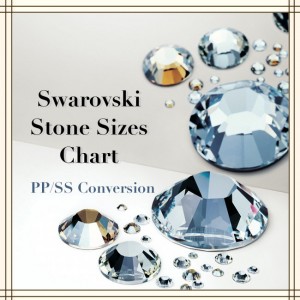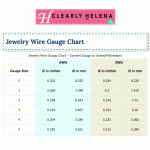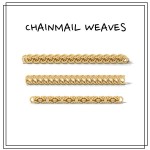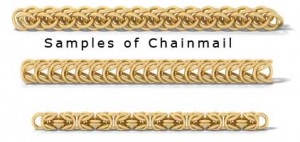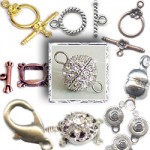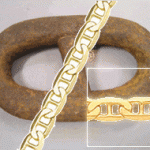Swarovski Stone Sizes as well as other crystal, stones, rhinestones, and flatbacks are often given the mysterious PP and/or SS sizing. PP and SS size terminology is a throwback from earlier times but is still extensively used by most industry leaders today. You can use our indispensable Swarovski Stone Sizes Chart to easily convert PP and/or SS sizing in millimeters and inches.
z.Swarovski Stone Sizes Chart
Swarovski uses PP and SS stone sizing as a very specific measurement for their high quality round stones. Without a Swarovski Stone Sizes Chart, it would be very difficult and confusing to estimate the size of Swarovski stones in millimeter and/or inches.
PP stands for “Pearl Plate” and SS stands for “Stone Size”. Discover why we have the PP and SS sizes for round stones.
The Swarovski Stone Sizes chart here is a very handy conversion guide, specifically for Swarovski crystals and stones. The information in the chart has been sourced from Swarovski™.
z.Wire Gauge Chart: Conversion Table
A useful handy Wire Gauge Chart which quickly lets you convert wire gauges to inches and millimeters. Covers the AWG and SWG gauge rating systems.
Jewelry Wire Gauge Chart
| AWG | SWG | |||
|---|---|---|---|---|
| Gauge Size | Ø in inches | Ø in mm | Ø in inches | Ø in mm |
| 0 | 0.325 | 8.252 | 0.324 | 8.229 |
| 1 | 0.289 | 7.348 | 0.3 | 7.619 |
| 2 | 0.258 | 6.543 | 0.276 | 7.01 |
| 3 | 0.229 | 5.827 | 0.252 | 6.40 |
| 4 | 0.204 | 5.189 | 0.232 | 5.892 |
| 5 | 0.182 | 4.621 | 0.212 | 5.384 |
| 6 | 0.162 | 4.115 | 0.192 | 4.876 |
| 7 | 0.144 | 3.665 | 0.176 | 4.470 |
| 8 | 0.129 | 3.264 | 0.16 | 4.064 |
| 9 | 0.114 | 2.906 | 0.144 | 3.657 |
| 10 | 0.102 | 2.588 | 0.128 | 3.251 |
| 11 | 0.091 | 2.304 | 0.116 | 2.946 |
| 12 | 0.0801 | 2.052 | 0.104 | 2.641 |
| 13 | 0.072 | 1.829 | 0.092 | 2.336 |
| 14 | 0.064 | 1.628 | 0.080 | 2.032 |
| 15 | 0.057 | 1.450 | 0.072 | 1.829 |
| 16 | 0.051 | 1.291 | 0.064 | 1.625 |
| 17 | 0.045 | 1.15 | 0.056 | 1.422 |
| 18 | 0.040 | 1.024 | 0.048 | 1.219 |
| 19 | 0.036 | 0.912 | 0.040 | 1.016 |
| 20 | 0.032 | 0.813 | 0.036 | 0.914 |
| 21 | 0.029 | 0.724 | 0.032 | 0.812 |
| 22 | 0.025 | 0.643 | 0.028 | 0.711 |
| 23 | 0.023 | 0.574 | 0.024 | 0.609 |
| 24 | 0.020 | 0.511 | 0.022 | 0.558 |
| 25 | 0.018 | 0.455 | 0.020 | 0.508 |
| 26 | 0.016 | 0.404 | 0.018 | 0.457 |
| 27 | 0.014 | 0.361 | 0.016 | 0.416 |
| 28 | 0.013 | 0.320 | 0.015 | 0.375 |
| 29 | 0.011 | 0.287 | 0.014 | 0.345 |
| 30 | 0.010 | 0.254 | 0.012 | 0.315 |
| 32 | same thickness as general sewing thread | |||
z.Chainmail Weaves: List
Here is a preliminary list of some of the most popular basic chainmail weaves. List includes level of expertise recommended, the AR (Aspect Ratio) recommended. It also contains links to great tutorials for each of the chainmail weaves.
Tip:
Good idea to use different coloured rings when first learning new chainmail weaves. It makes the learning process much easier.
z.Chain Mail and Aspect Ratio
This is a brief primer on chain mail basics. We will cover the very basic terminologies and provide some clarifying explanations. There are a lot of terminology connected with the ancient art of chain mail, but for now we will just concentrate on the basics. (You will naturally pick up more terminology as you progress).
For starters, chain mail is variously spelt as chainmail, chain maille, chainmaille, or just as maille.
zz.Jewelry Clasps – Basic Types
Pictures, descriptions, and explanations on some of the most popular, common, and basic types of jewelry clasps.
Jewelry Clasps are one of the jewelry findings that are most common and most essential. Bracelet clasps and necklace clasps are the most popular functional jewelry fasteners around.
Functionally, clasps are merely fasteners that are used to connect and end off bracelets, anklets, and necklaces. However clasps do not just have to be only functional. They can be an integral part of the design; sometimes the focal point of interest.
These days, there are more and more decorative jewelry clasps available for purchase. Clasps can come in many designs, many different finishes, and made from various grades of materials. For top end jewelry, sterling silver, gold, platinum, rhodium are common materials used to manufacture these jewelry fasteners.
As specialist companies continue to produce new clasps designs, it is impossible to produce a comprehensive list of jewelry clasps. However it is still useful to know some of the basic and long-enduring types of clasps available. [Read more…]
zz.Findings for Jewelry Making
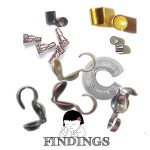
Findings for Jewelry Making
Am I being picky? Perhaps. But there is a difference between Jewelry Supplies and Jewelry Findings. Findings for Jewelry Making are really a sub-set of Jewelry supplies. Somethings just knowing the right industry label can help you find what you need faster, better, surer.
Jewelry Findings – these are the components that are used in jewelry making; normally the elements used to hold the jewelry piece together. They include clasps, jumprings, head and eye pins, earring hooks and backs, etc.
Jewelry Supplies on the other hands includes the findings for jewelry making as well as anything that is used in jewelry making: tools and pliers, beads and stones, threads and strings, and so on.
[Read more…]
zz.Jewelry Chains
Ever since jewelry making started exploding in popularity, the various types of jewelry chains have grown in desirability, variations, patterns, and names. However with such an explosive growth of new designs, the names of the various jewelry chains are not universal nor always descriptive.
In an attempt to keep up with some of the emerging jewelry chains as well as some of the standard classic, I have compiled a jewelry chains list that will likely grow over time as I come across new and fascinating chains for your craft and jewelry making creative adventures.
Types Of Jewelry Chains
(in alphabetical order)
Anchor Chain
Anchor chain’s origin is from the chains used to link an anchor to a vessel. This is one of the enduringly popular jewelry chains. Its variation, the Flat Anchor Chain is also very popular with it sleek and elegant appearance.

